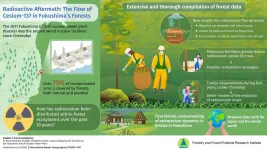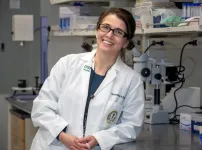(Press-News.org) In the race to stop the spread of COVID-19, a three-layer cloth mask that fits well can effectively filter COVID particles, says a group of UBC researchers.
After testing several different mask styles and 41 types of fabrics, they found that a mask consisting of two layers of low-thread-count quilting cotton plus a three-ply dried baby wipe filter was as effective as a commercial non-surgical mask at stopping particles--and almost as breathable.
The cloth masks filtered out up to 80 per cent of 3-micron particles, and more than 90 per cent of 10-micron particles.
"We focused on particles larger than one micron because these are likely most important to COVID-19 transmission," explains researcher Dr. Steven Rogak, a professor of mechanical engineering who studies aerosols. "While the COVID-19 virus is only around 0.1 micron in size, it is always attached to something larger, like the droplets produced by breathing, talking and coughing, which are typically in the micron and not submicron range."
World Health Organization guidelines recommend three layers for a non-medical mask: an absorbent inner layer near the mouth, a middle filtration layer and an outer layer exposed to the external environment.
Mask materials
The team recommends specific fabrics for different parts of the mask: double-knit cotton, quilting cotton, knit nylon or polyester satin for the outer layer, and double-knit cotton, quilting cotton or simple-weave silk for the inner layer that sits closest to the skin.
Nylon and polyester repel water, keeping harmful droplets from penetrating through to the inner layers. Cotton and silk feel comfortable, breathe well, and wick away moisture. Importantly, fabric construction is important to breathability and filtration efficiency. For example, fabrics such as polyester crepe (finely woven polyester), high thread-count cotton and dupion silk are not very breathable.
Dried baby wipes, which can be swapped out, make surprisingly good filters.
"Baby wipes are typically made of spunlace and spunbond polypropylene--similar to the types of polypropylene found in medical masks and N95 respirators," said researcher Dr. Jane Wang, a clinical professor in the faculty of medicine.
"They are breathable and trap particles efficiently. They're biocompatible, containing minimal preservatives and chemicals that may otherwise cause irritation or breathing problems."
Fit is paramount
Aside from choosing efficient, breathable materials, it's important to have a good seal around the mask, say the researchers.
"Even an N95 mask is going to take in large, massive droplets with lots of viruses if it does not seal against the face. A well-fitted, well-designed cloth mask with a baby-wipe filter will be more effective at filtering 5- or 10-micron particles than a poorly fitted N95 mask," said Dr. Rogak.
He added that the highest leak rates are around the nose, chin and the cheeks, and pleated-style masks tend to leak the most.
"The mask should not sit flat against your mouth and nose, because it will be less breathable, as there's only one very tiny portion of the fabric actually exchanging air. Even if it's made of breathable material, it won't feel that way. You need to create a bit of an air pocket, with a bigger curvature in front, so that the whole mask is engaged in air exchange."
In the end, masking is an intervention aimed at risk reduction, not risk elimination, says Dr. Wang.
"For the intervention to be effective, people need to have access to the intervention and to apply the intervention correctly. An N95 mask will not be effective if people are wearing it halfway down the face. Double masking will not be effective if people cannot tolerate it because of overheating, breathability or CO2 retention problems. The focus should always be to wear a mask correctly by choosing a design that offers a good seal around the nose and mouth and to avoid cross-contamination."
INFORMATION:
This study was recently published in the journal Aerosol Science and Technology. An interactive version of the data, and simplified mask design tool, is available at https://tsipkens.github.io/fmviz/
Dr. Wang continues to share information on The Free Mask Project website, a grassroots initiative she is spearheading.
The genus Ficus (figs) and their agaonid pollinating fig wasps are a classic example of coevolution. It represents perhaps the most extreme and ancient (about 75 million years) obligate pollination mutualism known.
Previous studies have suggested that pollinator host-switching and hybridization existed in some fig taxa with genetic evidence based on relatively few genes. However, those cases were mainly treated as rare exceptions, and strict-sense coevolution was still treated as the dominate coevolution model for the codiversification of this "extreme" obligate pollination system with high species richness.
Together with colleagues from 11 institutions from home and abroad, researchers from the Xishuangbanna Tropical Botanical ...
Scientists at Scripps Research have clarified the workings of a mysterious protein called Gαo, which is one of the most abundant proteins in the brain and, when mutated, causes severe movement disorders.
The findings, which appear in Cell Reports, are an advance in the basic understanding of how the brain controls muscles and could lead to treatments for children born with Gαo-mutation movement disorders. Such conditions--known as GNAO1-related neurodevelopmental disorders--were discovered only in the past decade, and are thought to affect at least hundreds of children around the world. Children with the disease suffer from severe developmental ...
World-first 3D printed oesophageal stents developed by the University of South Australia could revolutionise the delivery of chemotherapy drugs to provide more accurate, effective and personalised treatment for patients with oesophageal cancer.
Fabricated from polyurethane filament and incorporating the chemotherapy drug 5-fluorouracil (5-FU), the new oesophageal stents are the first to contain active pharmaceutical ingredients within their matrix .
Their unique composition allows them to deliver up to 110 days of a sustained anti-cancer medication directly to the cancer site, restricting further tumour growth.
Importantly, the capabilities of 3D printing enabling rapid creation of individually tailored stents with patient-specific geometries and drug dosages.
PhD ...
The COVID-19 pandemic is a great example of the importance of access to the Internet and to digital health information. Unfortunately, historical disparities in health care appear to be reflected in computer ownership, access to the Internet and use of digital health information. However, few studies have qualitatively explored reasons for digital health information disparity, especially in older adults.
A study led by Florida Atlantic University's Christine E. Lynn College of Nursing in collaboration with the Dana-Farber Cancer Institute and the University of Massachusetts Medical ...
A 30-year high in East African rainfall during 2018 and 2019 resulted in rising water levels and widespread flooding. The new study shows that emissions of methane - the second most important greenhouse gas - from flooded East African wetlands were substantially larger following these extreme rainfall events.
The study, led by Dr Mark Lunt from the University of Edinburgh's School of GeoSciences, used data from two different satellites in combination with an atmospheric model to evaluate methane emissions from East Africa. This included data from the European TROPOMI satellite instrument, launched in 2017, which provides information about atmospheric methane at ...
A new technique has taken the first images of muon particle beams. Nagoya University scientists designed the imaging technique with colleagues in Osaka University and KEK, Japan and describe it in the journal Scientific Reports. They plan to use it to assess the quality of these beams, which are being used more and more in advanced imaging applications.
Muons are charged particles that are 207 times the mass of electrons. They naturally form when cosmic rays strike atoms in the upper atmosphere, showering down onto every part of Earth's surface. They can penetrate through hundreds of meters of solids before being absorbed.
Scientists have used naturally ...
Tsukuba, Japan - Although exercise is known to enhance cognitive function and improve mental health, the neurological mechanisms of this link are unknown. Now, researchers from Japan have found evidence of the missing link between aerobic fitness and cognitive function.
In a study published in Medicine & Science in Sports & Exercise, researchers from the University of Tsukuba revealed that spontaneous eye blink rate (sEBR), which reflects activity of the dopamine system, could be used to understand the connection between cognitive function and aerobic fitness.
The dopaminergic system is known to be involved in physical activity and exercise, and previous researchers have proposed that exercise-induced changes in cognitive function might be mediated by activity ...
After the Chernobyl disaster of 1986, the 2011 Fukushima Daiichi nuclear power plant (FDNPP) disaster was the second worst nuclear incident in history. Its consequences were tremendous for the Japanese people and now, almost a decade later, they can still be felt both there and in the rest of the world. One of the main consequences of the event is the release of large amounts of cesium-137 (137Cs)--a radioactive "isotope" of cesium--into the atmosphere, which spread farther away from the power plant through wind and rainfall.
Considering the massive threat posed by 137Cs to the health of both humans and ecosystems, it is essential to understand how it has distributed and how much of it still lingers. This is why the ...
Tampa, FL (Feb. 3, 2021) -- A preclinical study by a END ...
The coronavirus pandemic forced states across the nation to transform the way their residents voted in 2020, ramping up get-out-the-vote messaging and allowing for more people than ever to vote by mail.
But what's the best way to let residents know about new voting rules? And how much does something like voting by mail increase voter turnout overall?
Political scientists Daniel Hopkins and Marc Meredith looked at these questions during Philadelphia's 2020 primary, and worked with city officials to run an experiment to see whether an inexpensive postcard campaign about mail-in voting would be effective. They partnered with Anjali Chainani, Nathaniel Olin, and Tiffany ...







